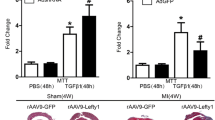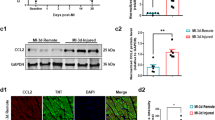Abstract
To examine the biological impact of locally expressed stromal cell-derived factor-1α (SDF-1α) during the acute phase of remodeling after myocardial infarction (MI), rats were treated with the selective CXCR4 receptor antagonist AMD3100 (1 mg/kg; given 24 h post-MI and continued for 6 days). In 1-week post-MI rats, intense SDF-1 immunoreactivity was detected in scar-residing vessels, and SDF-1α messenger ribonucleic acid (mRNA) levels were significantly greater in the infarct region compared to the noninfarcted left ventricle (NILV). AMD3100 treatment of post-MI rats reduced infarct size, improved systolic function, and partially suppressed the increased expression of atrial natriuretic peptide mRNA in the NILV. The latter finding indirectly suggests that SDF-1α may have contributed to the hypertrophic response of the NILV. SDF-1α treatment of neonatal rat ventricular myocytes (NNVMs) failed to promote protein synthesis. However, in hypertrophied NNVMs, SDF-1α treatment further augmented 3H-leucine uptake, and AMD3100 selectively inhibited the increase in protein synthesis. Collectively, these data support the existence of an SDF-1α gradient in the damaged rat myocardium increasing toward the infarct region and highlight the novel observation that AMD3100 antagonism of the SDF-1α/CXCR4 axis reduced scar expansion and improved contractility. In vitro data further suggest that SDF-1α may have contributed to the hypertrophic response of the NILV.




Similar content being viewed by others
References
Ahlers BA, Song J, Wang J et al (2005) Effects of sarcoplasmic reticulum Ca2+-ATPase overexpression in postinfarction rat myocytes. J Appl Physiol 98:2169–2176
Askari AT, Unzek S, Popovic ZB et al (2003) Effect of stromal cell-derived factor-1 on stem cell homing and tissue regeneration in ischaemic cardiomyopathy. Lancet 362:697–703
Broxmeyer HE, Orschell CM, Clapp DW et al (2005) Rapid mobilization of human and murine hematopoietic stem and progenitor cells with AMD3100, a CXCR4 antagonist. J Exp Med 201:1307–1308
Calderone A, Abdelaziz N, Colombo F, Schreiber KL, Rindt H (2000) A farnesyltransferase inhibitor attenuates cardiac myocyte hypertrophy and gene expression. J Mol Cell Cardiol 32:1127–1140
Dawn Abbot J, Huang Y, Liu D, Hickey R, Krause DS, Giordano FJ (2004) Stromal cell-derived factor-1α plays a critical role in stem cell recruitment to the heart after myocardial infarction but is not sufficient to induce homing in the absence of injury. Circulation 110:3300–3305
De Klerck B, Geboes L, Hatse S et al (2005) Pro-inflammatory properties of stromal cell-derived factor-1 (CXCL12) in collagen induced arthritis. Arthritis Res Ther 7:R1208–R1220
El-Helou V, Bel-Hadj S, Drapeau J, Clement R, Gosselin H, Calderone A (2006) Nitric oxide-mediated inhibition of DNA synthesis was attenuated in hypertrophied neonatal rat ventricular myocytes. Nitric Oxide 14:316–326
El-Helou V, Dupuis J, Proulx C et al (2005) Resident nestin(+) neural stem cells and fibres were detected in the normal and damaged rat myocardium. Hypertension 46:1219–1225
Hatse S, Princen K, Bridger G, De Clerq E, Schols D (2002) Chemokine receptor inhibition by AMD3100 is strictly confined to CXCR4. FEBS Lett 527:255–262
Hendrix CW, Flexner C, MacFarland RT et al (2000) Pharmacokinetics and safety of AMD-3100, a novel antagonist of the CXCR-4 chemokine receptor, in human volunteers. Antimicrob Agents Chemother 44:1667–1673
Hoffmeyer MR, Scalia R, Ross CR, Jones SP, Lefer DJ (2000) PR-39, a potent neutrophil inhibitor, attenuates myocardial ischemia-reperfusion injury in mice. Am J Physiol 279:H2824–H2828
Kuwahara F, Kai H, Tokuda K et al (2002) Transforming growth factor-beta function blocking prevents myocardial fibrosis and diastolic dysfunction in pressure-overloaded rats. Circulation 106:130–135
Liles WC, Broxmeyer HE, Rodger E et al (2003) Mobilization of hematopoietic progenitor cells in health volunteers by AMD3100, a CXCR4 antagonist. Blood 102:2728–2730
Ma J, Ge J, Zhang S et al (2005) Time course of myocardial stromal cell-derived factor 1 expression and beneficial effects of intravenously administered bone marrow cells in rats with experimental myocardial infarction. Basic Res Cardiol 100:217–223
Mercier I, Pham-Dang M, Clement R, Colombo F, Gosselin H, Calderone A (2002) Elevated mean arterial pressure in the ovariectomized rat was normalized by ETA receptor antagonist therapy: absence of cardiac hypertrophy and fibrosis. Br J Pharmacol 136:685–692
Molkentin JD, Lu JR, Antos CL, Robbins J, Grant SR, Olson EN (1998) A calcineurin-dependent transcriptional pathway for cardiac hypertrophy. Cell 93:215–228
Nguyen QT, Colombo F, Clement R, Rouleau JL, Calderone A (2003) AT1 receptor antagonist therapy preferentially ameliorated right ventricular function and phenotype during the early phase of remodeling post-MI. Br J Pharmacol 138:1485–1494
Orlic D, Kajstura J, Chimenti S et al (2001) Bone marrow cells regenerate infarcted myocardium. Nature 410:701–705
Plllarisetti K, Gupta SK (2001) Cloning and relative expression analysis of rat stromal cell derived factor-1 (SDF-1): SDF-1 alpha mRNA is selectively induced in rat model of myocardial infarction. Inflammation 25:293–300
Pyo RT, Sui J, Dhume A et al (2006) CXCR4 modulates contractility in adult cardiac myocytes. J Mol Cell Cardiol 41:834–844
Qi M, Shannon TR, Euler DE, Bers DM, Samarel AM (1997) Downregulation of sarcoplasmic reticulum Ca(2+)-ATPase during progression of left ventricular hypertrophy. Am J Physiol 272:H2416–H2424
Rubin JB, Kung AL, Klein RS et al (2003) A small-molecule antagonist of CXCR4 inhibits intracranial growth of primary brain tumors. Proc Natl Acad Sci USA 100:13513–13518
Schober A, Knarren S, Lietz M, Lin EA, Weber C (2003) Crucial role of stromal cell-derived factor-1á in neointima formation after vascular injury in apolipoprotein E-deficient mice. Circulation 108:2491–2497
Segret A, Ricker-Martin C, Pavoine C et al (2007) Structural localization and expression of CXCL12 and CXCR4 in rat heart and isolated cardiac myocytes. J Histochem Cytochem 55:141–150
Shepherd RM, Capoccia BJ, Devine SM et al (2006) Angiogenic cells can be rapidly mobilized and efficiently harvested from the blood following treatment with AMD3100. Blood 108:3662–3667
Suratt BT, Petty JM, Young SK et al (2004) Role of CXCR4/SDF-1 chemokine axis in circulating neutrophil homeostasis. Blood 104:565–571
Tarzami ST, Miao W, Lopez L, Factor SM, Berman JW, Kitsis RN (2003) Opposing effects mediated by the chemokine receptor CXCR2 on myocardial ischemia-reperfusion injury: recruitment of potentially damaging neutrophils and direct myocardial protection. Circulation 108:2387–2392
Ti TLY, Chen J, Bao W et al (2001) In vivo myocardial protection from ischemia/reperfusion injury by the peroxisome proliferator-activated receptor-gamma agonist rosiglitazone. Circulation 104:2588–2594
Wang Y, Ahmad N, Wani MA, Ashraf M (2004) Hepatocyte growth factor prevents ventricular remodelling and dysfunction in mice via Akt pathway and angiogenesis. J Mol Cell Cardiol 37:1041–1052
Yamaguchi J, Kusano KF, Masuo O et al (2003) Stromal cell-derived factor-1 effects on ex vivo expanded endothelial progenitor cell recruitment for ischemic neovascularization. Circulation 107:1322–1328
Zarain-Herzberg A (2006) Regulation of the sarcoplasmic recticulum Ca2+-ATPase expression in the hypertrophic and failing heart. Can J Physiol Pharmacol 84:509–521
Zhang XQ, Tillotson DL, Moore RL et al (1996) Na+f–Ca+ exchange currents and SR Ca2+ content in adult myocytes. Am J Physiol Cell Physiol 281:H2079–H2088
Acknowledgments
This work was supported by the Heart and Stroke Foundation of Canada and Quebec, Canadian Institutes of Health Research, and “La Fondation de l’Institut de Cardiologie de Montréal.” Dr. Calderone is a “Chercheur–Boursier National du Fonds de la recherche en santé du Québec.” I would like to thank France Thériault for excellent secretarial assistance. Cindy Proulx and Viviane El-Helou contributed equally to the study.
Author information
Authors and Affiliations
Corresponding author
Rights and permissions
About this article
Cite this article
Proulx, C., El-Helou, V., Gosselin, H. et al. Antagonism of stromal cell-derived factor-1α reduces infarct size and improves ventricular function after myocardial infarction. Pflugers Arch - Eur J Physiol 455, 241–250 (2007). https://doi.org/10.1007/s00424-007-0284-5
Received:
Accepted:
Published:
Issue Date:
DOI: https://doi.org/10.1007/s00424-007-0284-5




